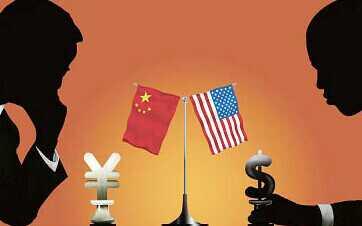
This past year, particularly since Trump took office, a few American scholars and politicians have liked to hype the so-called U.S.-Sino trade imbalance issue. Some have been creating false formulas, theories, and “facts.” Nevertheless, the substance behind this false proposition cannot be concealed.
In order to make sense of this issue, we could first play a bookkeeping game. Suppose that the premise is this: the exchange rate of the Chinese renminbi to the U.S. dollar is 1:1, and we are just counting wages and discounting all other costs and taxes. An American furniture company employs three people to chop down some timber, and each is paid $100, totaling $300; eight people make the furniture, and each is paid $100, totaling $800. If the furniture is only sold in the American domestic market, the value is $1100.
If this company decided to trade internationally and moved the timber to China first, the price of chopping the timber in America stays the same, but when employing eight people in China to make the furniture, each earning $50, the total becomes $400. The furniture value back in America is $700, which is a $400 difference compared to the product being manufactured in America.
During the process, the American gross domestic product has sunk by $800, available jobs have decreased by eight, and the value of American exports to China has increased in value by $300. China increases its total GDP by $400, creates eight more jobs, and earns $400 in wages. In returning the timber priced at $700 to America, China’s exports to America have increased by $700, achieving a surplus of $400; the total value of international trade created by this one transaction has increased by $1000. Meanwhile, in America, the furniture company’s unit price has been reduced from $1100 to $700, the consumer has spent $400 less, and China’s trade surplus and foreign exchange reserves have increased by $400.
Is there anything “unfair” about this? If the timber is not sold in China, then it could be said almost nothing is unfair here, and it just goes to show that the foundation of mutually profitable business transactions is free trade. If both sides’ comparative advantages are developed simultaneously, resource application can be optimized and production efficiency raised.
In China, there is a great number of people who need work in rural areas, therefore, increasing the number of jobs in the production trade does not have an impact on jobs in agriculture. This maintains low wages in the long term and is the foundation for a “win-win” situation. Previously, it was the “international new left,” yet now America is extremely right wing, and Americans believe that this is unfair trade; it is very clear that they are mistaken. Their mistake lies in the fact that Western economists frequently assume full employment, emphasizing fair market dominance and not realizing the even more basic fundamental question of what “surplus” is. The reason that there is bilateral “structural economic friction” is because despite the increased material benefit to the American consumer, the available jobs, wages and gross national product have decreased, whereas China’s corresponding quotas and foreign exchange reserves have increased.
Those economists are further mistaken by not considering the comparative advantages from a development-oriented point of view. In the 1980s, the American workforce lacked people to fill positions, but there was a surplus of timber. China had a surplus of 400 million workers, and wages for migrant workers were extremely low. The difference with American wages was tenfold; it lacked timber, the means of exporting and foreign currency exchanges. It was clear at that time how both sides benefited each other economically.
Forty years later, China no longer has a workforce surplus, wages have risen, the production trade is concentrated on manufacturing products and its advantage is waning as production sites are shifting to Southeast Asia and Latin America, in contrast with foreign exchange reserves surplus. Now, American consumers view the material benefit to themselves, brought about by low production costs, etc., as if this is how it should be by right, and they are not at all grateful, and yet part of this long-term unemployment is strongly demonstrated by political interest groups. Finding work for these people is the American government’s social responsibility, but outward distractions and messy protectionism means that the ultimate loser is America itself.
Considering the pressure of American politics and public opinion, China could reach a bilateral agreement with the U.S. and reduce the trade surplus with the U.S. at a certain point. It could increase American imports, especially imports involving the service trade, and correspondingly, the U.S. could decrease restrictions on Chinese exports. China could invest in labor-intensive products in the American domestic market, and American entrepreneurs could recall parts of the manufacturing process from China. America could enter the “One Belt, One Road” initiative, and China could participate in American infrastructure construction via investments or loans and launch a production cooperative of steel, cement and glass, etc. China could continue to improve the domestic investment environment and continue to decrease unreasonable subsidies to domestic companies.
Since the establishment of U.S.-Sino cooperation, there has been a history of mutually profitable situations. America should fully recognize that unilateral trade wars and making threats of extortion will mean that both sides lose out.

Leave a Reply
You must be logged in to post a comment.